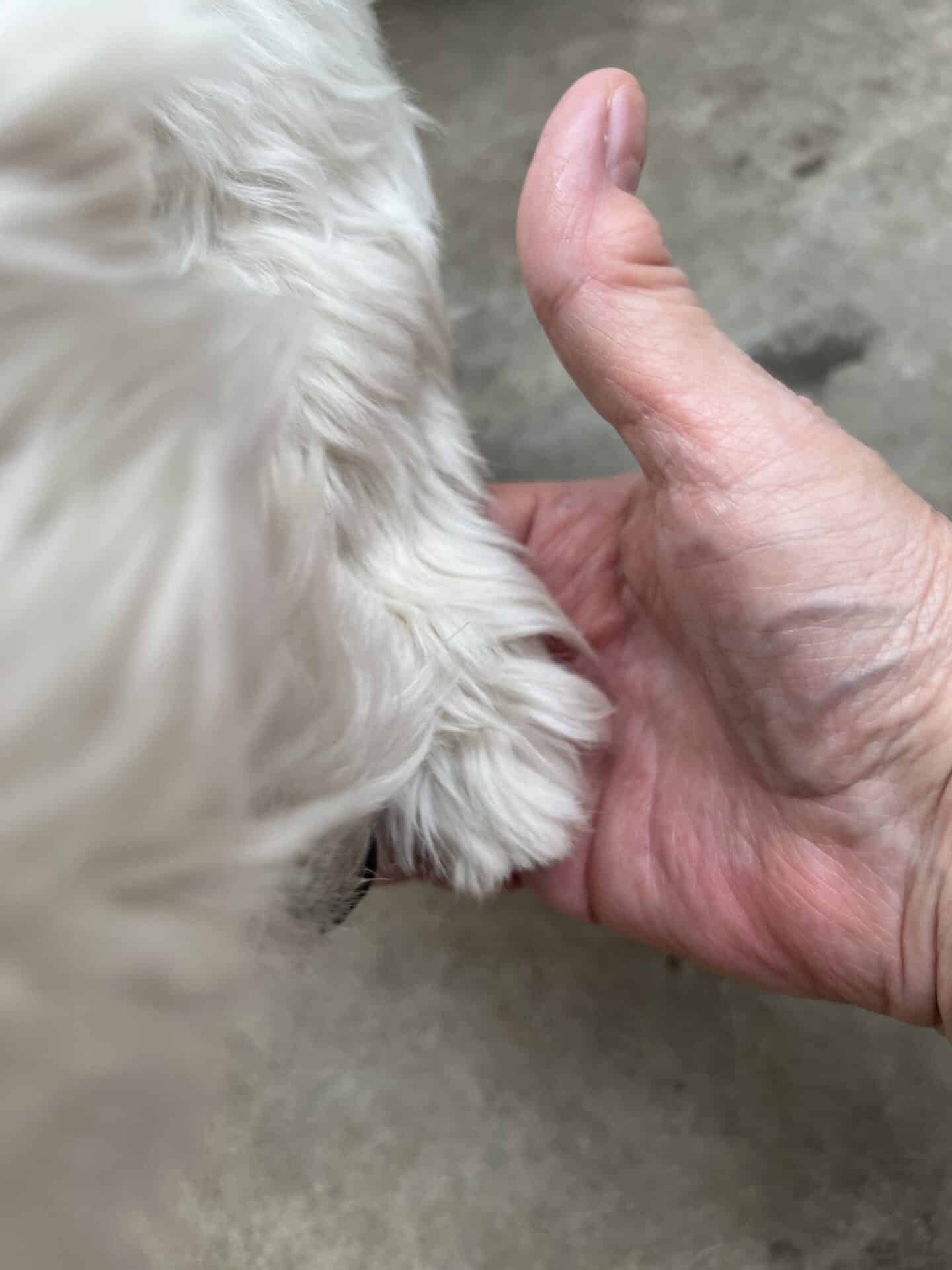When it’s time for me to take a break from writing, I grab the nail clippers and treats from my dog drawer, and settle into a comfortable chair.
I call my guest, the adorable adolescent Lab, Layla, and reward her prompt arrival. I set the timer on my phone for one minute and hit “start.”
I hold my open right hand between us, palm up. We’ve practiced “shake” many times so she immediately understands the game and places her paw on my hand. I reward her. We repeat this two more times.

On the third repetition I hold one toe between my thumb and forefinger, while squeezing the nail clipper closed (for the sound it makes) with my other hand. I reward Layla for her cooperation. We repeat this three times.
On the last sequence I gently touch the underside of one of her claws with the clipper while squeezing it closed. I’m making contact with the nail but not cutting it, yet. Then I reward her.
As the timer rings I stand and toss a treat a few feet away for Layla to chase as I tell her to “find it.” She bounces off.
This is an example of how I teach puppies and fearful, anxious, or reactive dogs how to choose to participate in a behavior that’s new, or one they’ve previously been afraid of. We refer to this process as “conditioning.” The ultimate goal is for puppies and dogs to learn to cooperate in small, predicable, enjoyable increments. We refer to this as “cooperative care.”
One minute training sessions are a great way to build trust. There’s no pressure to achieve the end result, and the session doesn’t exceed a puppy’s or dog’s patience, interest, or compelling desire to do something else. Both human and canine remain relaxed, and we’re one step closer to a calm, cooperative behavior.
Setting an alarm to go off once an hour while working, doing laundry, or watching TV is a perfect reminder to constructively engage with your puppy or dog. When we operate in the spirit of mutual cooperation, our canine companions enjoy the game and our relish in our attention. We have the satisfaction of knowing their brain has been exercised, we’re moving towards our training goal, and simultaneously building trust between us.
Taking time to break the behavior goals down into tiny baby steps should happen before the session begins. That way you’ll know what you’re doing and where you’re going. Try to visualize the end goal from your dog’s perspective, then work backwards.
- What will it feel like?
- Which steps will be unfamiliar?
- Which steps will benefit from familiar behaviors?
Consider ways you can maximize your puppy’s or dog’s enjoyment:
- Avoid training shortly after your pup has consumed a meal, or during their regular nap time.
- Use a variety of rewards. I avoid using the same treat 2 days in a row, for example.
- Express happy, fun, positive energy towards your pup. Your tone, facial expression, and patience level speak loudly to a puppy or dog.
- Make sure your canine companion’s had the opportunity to relieve themselves decently, before you start.
What can you train in one minute?
Recall – toss a treat a few feet away. As your puppy or dog consumes it, call them to you. Reward the instant they arrive (if you ask them to sit before rewarding them, you’re rewarding the “sit” in your pup’s mind, not the recall). Repeat.
Stay – ask your puppy or dog to sit. Reward them. Shift your weight from one foot to the other. If they “stay,” reward them. If they don’t, repeat until they do. Next, take one step back and immediately return. Reward. Add one step with every repetition.
Desensitize to touch – if your puppy or dog is unfamiliar or uncooperative with having any part of their body touched, lightly touch them near a target area then reward. Don’t start by elevating a paw, for example, just touch the paw lightly then reward, over and over, for a one minute session. This is an excellent way to begin teach them to enjoy brushing, nail trimming, ear cleaning, toothbrushing, or any other sort of handling.
Literally any behavior can be taught and/or practiced, one minute at a time. You’ll be amazed at how quickly your puppy or dog learns, and how they begin to cooperate rather than resist.
©️2025 Dee Green SantaMonicaDogCoach.com
Dee Green has been a professional dog trainer and canine behavior consultant for more than 20 years. She specializes in building trust-based, cooperative relationships between guardians and puppies up to 18 months, and fearful, anxious, and reactive dogs of all ages.
